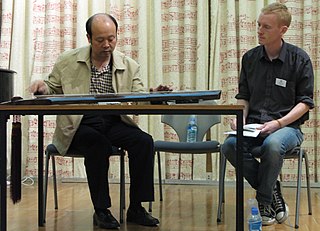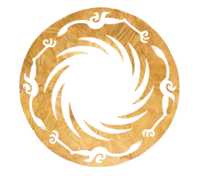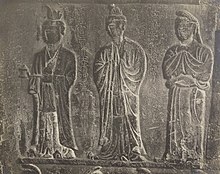
Sichuan is a province in Southwestern China occupying the Sichuan Basin and Tibetan Plateau between the Jinsha River on the west, the Daba Mountains in the north and the Yungui Plateau to the south. Sichuan's capital city is Chengdu; its population stands at 83 million. Sichuan neighbors Qinghai to the northwest, Gansu to the north, Shaanxi to the northeast, Chongqing to the east, Guizhou to the southeast, Yunnan to the south, and Tibet to the west.

Mianyang is the second largest prefecture-level city of Sichuan province in Southwestern China. Located in north-central Sichuan covering an area of 20,281 square kilometres (7,831 sq mi) consisting of Jiangyou, a county-level city, five counties, and three urban districts. Its total population was 4,868,243 people at the 2020 Chinese census, of whom 2,232,865 live in its built-up area made of three urban districts.
The Di (Chinese: 氐; pinyin: Dī; Wade–Giles: Ti1; < Eastern Han Chinese *tei < Old Chinese (B-S): *tˤij) were an ancient ethnic group that lived in western China, and are best known as one of the non-Han Chinese peoples known as the Five Barbarians that seized power in northern China during the Sixteen Kingdoms period. This ethnic group should not be confused with the earlier Dí (狄), which refers to unrelated nomadic peoples in northern China during the earlier Zhou dynasty. The Di are thought to have been of proto-Tibetan origin, though there is a widespread belief among Chinese scholars that the Di spoke a Turkic language. The Ba-Di (巴氐) were a branch of the Di that intermixed with another ethnic group known as the Cong people (賨).

Shu (Chinese: 蜀; Sichuanese Pinyin: Su2; former romanization: Shuh), also known as Ancient Shu (Chinese: 古蜀) in historiography, was an ancient kingdom in what is now Sichuan Province. It was based on the Chengdu Plain, in the western Sichuan basin with some extension northeast to the upper Han River valley. To the east was the Ba tribal confederation. Further east down the Han and Yangtze rivers was the State of Chu. To the north over the Qinling Mountains was the State of Qin. To the west and south were tribal peoples of little military power.

Bazhong is a prefecture-level city in north-eastern Sichuan province, China. Its population was 2,712,894 at the 2020 census whom 1,064,766 lived in Bazhou and Enyang urban districts.

Sichuanese or Szechwanese (simplified Chinese: 四川话; traditional Chinese: 四川話; Sichuanese Pinyin: Si4cuan1hua4; pinyin: Sìchuānhuà; Wade–Giles: Szŭ4-ch'uan1-hua4), also called Sichuanese/Szechwanese Mandarin (simplified Chinese: 四川官话; traditional Chinese: 四川官話; pinyin: Sìchuān Guānhuà), is a branch of Southwestern Mandarin spoken mainly in Sichuan and Chongqing, which was part of Sichuan Province until 1997, and the adjacent regions of their neighboring provinces, such as Hubei, Guizhou, Yunnan, Hunan and Shaanxi. Although "Sichuanese" is often synonymous with the Chengdu-Chongqing dialect, there is still a great amount of diversity among the Sichuanese dialects, some of which are mutually unintelligible with each other. In addition, because Sichuanese is the lingua franca in Sichuan, Chongqing and part of Tibet, it is also used by many Tibetan, Yi, Qiang and other ethnic minority groups as a second language.

Southwestern Mandarin, also known as Upper Yangtze Mandarin, is a Mandarin Chinese dialect spoken in much of Southwestern China, including in Sichuan, Yunnan, Chongqing, Guizhou, most parts of Hubei, the northwestern part of Hunan, the northern part of Guangxi and some southern parts of Shaanxi and Gansu.

The Bo people are an ancient extinct people from the Yunnan and Sichuan provinces of Southwestern China. They are famous for their hanging coffins. They were one of the various now extinct peoples from Southern China known collectively in Chinese records as the Baipu.

Jiange County is a county of Sichuan Province, China. It is under the administration of Guangyuan city. The history of Jiange County as a county division goes back around 1700 years. The county has historically been a junction between the north and south of Western China, through the Jianmen Pass. It is a popular tourist destination in Sichuan.
Differing literary and colloquial readings for certain Chinese characters are a common feature of many Chinese varieties, and the reading distinctions for these linguistic doublets often typify a dialect group. Literary readings are usually used in loanwords, names, literary works, and in formal settings, while colloquial/vernacular readings are usually used in everyday vernacular speech.
Sichuanese Pinyin (Si4cuan1hua4 Pin1yin1; simplified Chinese: 四川话拼音; traditional Chinese: 四川話拼音; pinyin: Sìchuānhuà pīnyīn), is a romanization system specifically designed for the Chengdu dialect of Sichuanese. It is mostly used in selected Sichuanese dictionaries, such as the Sichuan Dialect Dictionary, Sichuan Dialect's Vocabulary Explanation, and the Chengdu Dialect Dictionary. Sichuanese Pinyin is based on Hanyu Pinyin, the only Chinese romanization system officially instructed within the People's Republic of China, for convenience amongst users. However, Hanyu Pinyin is unable to match the phonology of Sichuanese with complete precision, especially in the case for the Minjiang dialect, as there are many differences between Sichuanese and Standard Chinese in phonology.

The Minjiang dialect is a branch of Sichuanese, spoken mainly in the Min River (Mínjiāng) valley or along the Yangtze in the southern and western parts of the Sichuan Basin in China. There is also a language island of the Minjiang dialect located in the center of the Sichuan Basin covering several counties, including all of Xichong, Yanting, and Shehong Counties, and part of Jiange, Cangxi, Nanbu, Langzhong and Bazhong. The Minjiang dialect is also referred to as the Nanlu dialect by some scholars.
Ba–Shu Chinese (Chinese: 巴蜀語; pinyin: Bāshǔyǔ; Wade–Giles: Ba1 Shu3 Yü3; Sichuanese Pinyin: Ba¹su²yu³; IPA:[pa˥su˨˩y˥˧]), or simply Shu Chinese (Chinese: 蜀語), also known as Old Sichuanese, is an extinct Chinese language formerly spoken in what is now Sichuan and Chongqing, China.
The Leshan dialect (simplified Chinese: 乐山话; traditional Chinese: 樂山話; pinyin: Lèshānhuà; Sichuanese Standard Chinese: No2san1hua4; local pronunciation:[nʊʔ3sã55xuɑ224]) is the Sichuanese dialect of the city of Leshan and is a variety of Minjiang. It preserves old southern (Ba-Shu) features lost in other Sichuanese dialects and is very different from the dialects of most other cities in the province of Sichuan, which are more typically Mandarin.

Chengdu-Chongqing dialect or Cheng–Yu is the most widely used branch of Southwestern Mandarin, with about 90 million speakers. It is named after Chengdu, the capital city of Sichuan, and Chongqing, which was split from Sichuan in 1997. It is spoken mainly in northern and eastern Sichuan, the northeastern part of the Chengdu Plain, several cities or counties in southwestern Sichuan, southern Shaanxi and western Hubei.
Sichuanese characters (Chinese: 四川方言字; Sichuanese Pinyin: Si4cuan1 Fang1yan2zi4; pinyin: Sìchuān Fāngyánzì) are those Chinese characters used only in written Sichuanese. Sichuanese characters are often created as ideogrammatic compound characters (会意字) or phono-semantic compound characters (形声字).

The Shu School of Qin Music (蜀派古琴) refers to the modern guqin regional performance style tradition and lineage begun in the mid-19th century by its founder, Zhang Kongshan. The "Shu" name derives from the main base of operations at the time, namely the Sichuan region of China. Today, the Shu School has many branches and lineages, most of which trace their foundation to Zhang Kongshan, though the term is equally applied to Sichuan-based players in general.

Ba-Shu culture refers to a regional culture centered around Sichuan province and Chongqing city, also encompassing parts of Yunnan, Guizhou, southwestern Shaanxi and neighboring regions which speak Southwestern Mandarin. Historically centered around the Yangtze River, it emerged as an amalgamation of the cultures of the Shu and Ba kingdoms after their conquest by the State of Qin. The discovery of the Shu site of Sanxingdui in 1986 and Jinsha in 2001 places the Ba-Shu culture's age at nearly four millenia old; consequently, it is widely considered to be one of the cradles of Chinese civilisation and culture.

Sichuan embroidery or Shu embroidery, is a style of embroidery folk art native to Sichuan and Chongqing, particularly renowned for its brocade fabrics known as Shu brocade. This technique of embroidery originates from Chengdu, the capital of Sichuan, during the time of the Ancient Kingdom of Shu. An excavation of four tombs dating back to the Western Han dynasty, on Mount Laoguan located in Tianhui Town, Chengdu, has confirmed the use of patterning looms for weaving warp-faced compounds in that period.

Islam is a minority religion in the Chinese province of Sichuan. The total number of Muslims are 112,478 according to a 2004 census conducted by the Islamic Association of China, the majority are ethnic Hui. Chengdu, the provincial capital, and Xichang, capital of the Liangshan Yi Autonomous Prefecture, are the two cities with high concentration and long history of the Hui communities. According to a 1990 census, 23,288 Muslims resided in Ngawa Tibetan and Qiang Autonomous Prefecture of western Sichuan, with about 40 mosques catering to their religious needs. Counties with highest number of Muslims in this region are Ma'o, Ngawa, Quqên, Sirza Degu, Sungqu, Tsanlha, and Zoigê.
















